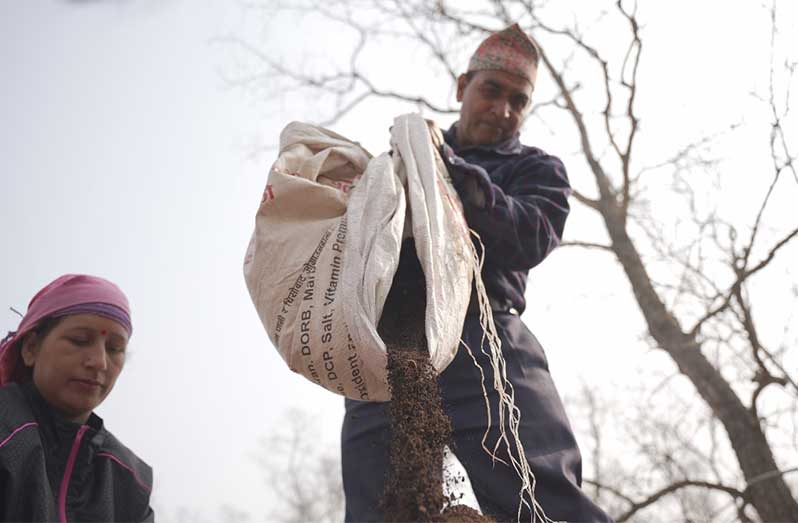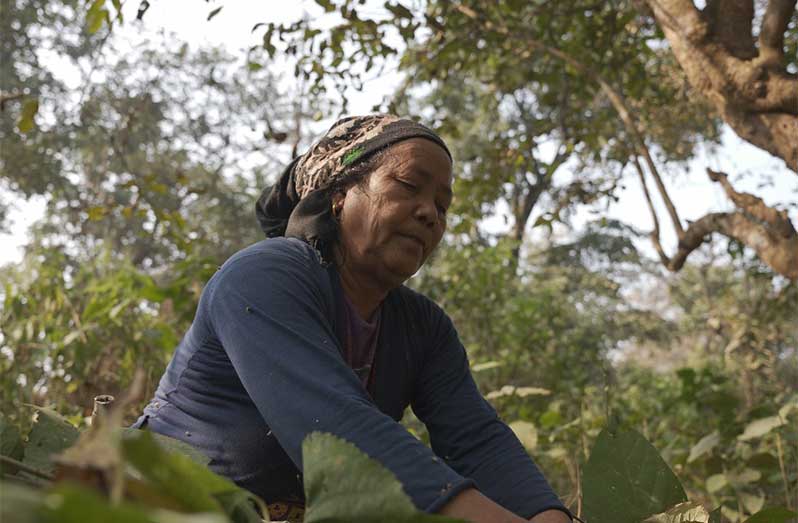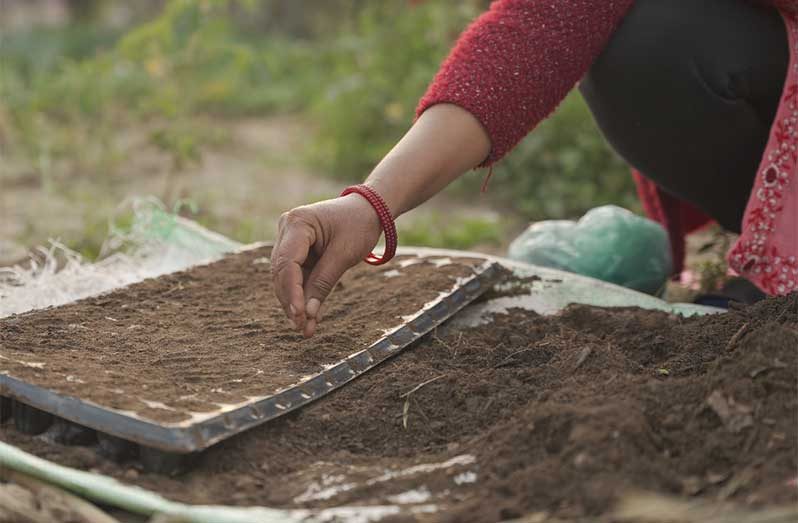–Nepal’s forest women transform crisis into opportunity
(FAO) – IN the quiet forests of Nepal’s Nawalpur District, a revolution is taking root with the most unlikely tools — cutters and compost heaps. A group of women in Binayi Triveni are turning what was once one of the region’s greatest threats into a promising economic opportunity.
At first light, Meena Poudel, 41, bends low beneath the spindly canopy of Sal and Beech trees, her hands rustling through the forest floor’s quilt of crisp, bronze-dusted leaves. Their edges are brittle and sun-scoured, curled inward like sleeping insects.
Around her, other women move with quiet coordination, slicing through the bramble and deadwood with blades dulled from daily use. The forest breathes easier with each sweep— the tangled underbrush that once fed wildfires now gathered for something new: a slow alchemy into organic fertiliser.
Meena’s work has not only built a thriving local economy but has also contributed to a 70 per cent reduction in forest fires over the past year. What began as survival has become stewardship, and a local economy built leaf by leaf.

“By removing unnecessary material from the forest floor, we have significantly reduced the risk of fires,” she says. “With fewer fires, the environment has become cleaner, which has also had a direct positive impact on human health. “Additionally, the bio-fertilisers we produce after processing the material are ‘organically pure,’ making them safer for human health and more suitable and environmentally friendly.”
Serving as Secretary, Meena manages the day-to-day operations of the Binayi Community Forest User Group, a community collective dedicated to responsible management of the forest. What she and her colleagues are doing represents a fundamental shift in how communities approach environmental threats.
Rather than treating forest fire prevention as merely a defensive measure, they’ve created a proactive business model that converts risks into opportunity. Their business now produces over 60 000 kilograms annually, with ambitious plans to more than double production to 125 000 kilograms.
The branches— collected themselves or purchased from local women for two rupees—enter a carefully managed processing cycle. Once collected, the biomass is fed through a cutter that shreds the branches and bushes into smaller pieces, accelerating decomposition.
After shredding, the biomass is methodically layered—balancing dry and green materials to ensure optimal conditions—and placed in long, narrow piles known as windrows, which allow organic material to decompose naturally in the open air. The piles are regularly turned to introduce oxygen, while moisture and temperature levels are closely monitored to maintain microbial activity and ensure efficient breakdown over a period of about 90 days.
To enhance the process, agriculturally beneficial native microorganisms are added, transforming the compost into an environmentally friendly biofertiliser. The final stabilised product not only provides essential nutrients to plants but also helps restore soil health and microbial biodiversity—key factors in maintaining and improving long-term soil fertility.
This seemingly simple process has profound implications. The organic fertiliser they produce helps local farmers transition away from chemical inputs, improving soil health and crop yields across the region. And perhaps most significantly, the business now provides income opportunities for 400 people in an area where employment, particularly for women, has been scarce.
The transformation from forest fire risk to enterprise began with local action, but it gained momentum through coordinated support. Investment followed effort. The local municipality matched the group’s initial capital.
In 2023, the Forest and Farm Facility (FFF) of the Food and Agriculture Organisation of the United Nations (FAO) provided USD 25 000 in catalytic funding. The FFF began by conducting a readiness exercise to assess the group’s potential, then supported training in forest management, composting
techniques and market-based value addition. These steps helped ensure the enterprise was not only environmentally sound, but also economically viable.
They received support to draft a business plan, conduct market analysis and meet product quality standards. Participation in cross-sectoral meetings helped the women navigate local bureaucracy and build alliances with nearby communities. These combined efforts transformed the group from informal volunteers into credible entrepreneurs.
Farmers in the region, increasingly wary of the long-term effects of chemical inputs, have turned to Binayi’s organic alternative. Many report not only healthier crops, but also better soil texture and fewer plant diseases. One farmer tested three different fertilisers on the same plot—only Binayi’s compost produced consistent, vigorous growth throughout the season.
The enterprise’s impact ripples beyond the forest. Women who once depended on others now fund their children’s education. Meena now pays for her son’s bachelor’s degree in Kathmandu, while continuing to manage her household and lead the business from home.
Now, Meena says, their work is not just about building their own capacity—but lifting others. “It is not just about developing our own capabilities but also about teaching and empowering others,” she says. “We are actively working to enhance their skills, connect them to the industry and bring more women into leadership positions.”
They are not finished. The forest stretches far beyond their community, and they are not yet immune to fire. But each day, their movement grows—one handful of forest debris at a time, one more neighbour trained, one more nursery nourished. A women’s movement that started in one forest now touches six. Soon, they plan to work across 42, reducing forest fires and building economies along the way.





.jpg)








